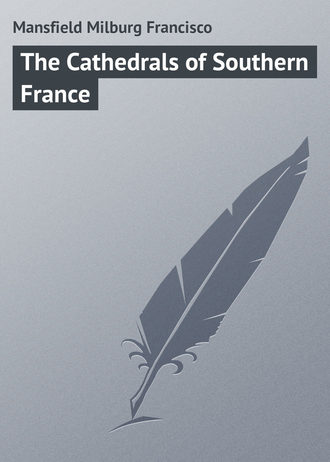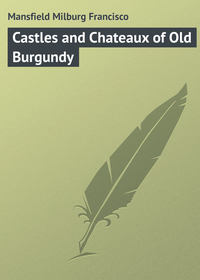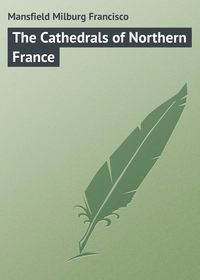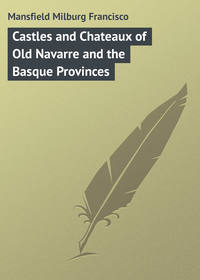 полная версия
полная версияThe Cathedrals of Southern France
No mention of Avignon, or of Arles, or of Nîmes could well be made without a reference to the revival of Provençal literature brought about by the famous "Félibrage," that brotherhood founded by seven poets, of whom Frederic Mistral is the most popularly known.
The subject is too vast, and too vastly interesting to be slighted here, so perforce mere mention must suffice.
The word Félibre was suggested by Mistral, who found it in an old hymn. Its etymology is uncertain, but possibly it is from the Greek, meaning "a lover of the beautiful."
The original number of the Félibres was seven, and they first met on the fête-day of Ste. Estelle; in whose honour they adopted the seven-pointed star as their emblem. Significantly, the number seven has much to do with the Félibres and Avignon alike. The enthusiastic Félibre tells of Avignon's seven churches, its seven gates, seven colleges, seven hospitals, and seven popes – who reigned at Avignon for seven decades; and further that the word Félibre has seven letters, as, also, has the name of Mistral, one of its seven founders – who took seven years in writing his epics.
The machicolated walls, towers, and gateways of Avignon, which protected the city in mediæval times, and – history tells us – sheltered twice as many souls as now, are in a remarkable state of preservation and completeness, and rank foremost among the masterworks of fortification of their time. This outer wall, or enceinte, was built at the instigation of Clement VI., in 1349, and was the work of but fourteen years.
A hideously decorated building opposite the papal palace – now the Conservatoire de Musique– was formerly the papal mint.
The ruined bridge of St. Bénezet, built in the twelfth century, is a remarkable example of the engineering skill of the time. Surmounting the four remaining arches – still perfect as to their configuration – is a tiny chapel dedicated to St. Nicholas, which formerly contained reliques of St. Bénezet.
The extraordinary circumstance which led up to the building of this bridge seems legendary, to say the least.
It is recorded that St. Bénezet, its founder, who was a mere shepherd, became inspired by God to undertake this great work. The inspiration must likewise have brought with it not a little of the uncommon skill of the bridge-builder, and, considering the extent and scope of the projected work, something of the spirit of benefaction as well.
The foundation was laid in 1171, and it was completed, after seventeen years of labour, in 1188.
On this bridge, near the entrance to the city, was erected a hospital of religious persons, who were denominated Les Frères du Pont, their offices being to preserve the fabric, and to afford succour to all manner of travellers.
The boldness and utility of this undertaking, – it being the only means of communication between Avignon and the French territory beyond the Rhône, – as well as the permanency assured to it by the annexing of a religious foundation, cannot fail to grant to the memory of its holy founder something more than a due share of veneration on behalf of his genius and perspicacity.
XI
ST. SIFFREIN DE CARPENTRAS
The tiny city of Carpentras, most picturesquely situated on the equally diminutive river Auzon which enters the Rhône between Orange and Avignon, was a Roman colony under Augustus, and a bishopric under St. Valentin in the third century.
A suffragan of Avignon, the papal city, the see was suppressed in 1790.
The Bishops of Carpentras, it would appear, were a romantic and luxury-loving line of prelates, though this perhaps is aught against their more devout virtues.
They had a magnificent palace overhanging the famous "Fountain of Vaucluse," and repaired thither in mediæval times for the relaxation which they evidently much appreciated. They must have been veritable patrons of literature and the arts, as Petrarch and his fellows-in-art were frequently of their household.
The ancient cathedral of St. Siffrein is dedicated to a former bishop of Carpentras, who died in the sixth century.
As this church now stands, its stones are mainly of the early sixteenth century. The west façade is entirely without character, and is pierced at the pavement with a gross central doorway flanked by two others; poor copies of the Greco-Romain style, which, in many of its original forms, was certainly more pleasing than here. Each of these smaller doorways have for their jambs two beautifully toned columns of red jasper, from a baptistère of which there are still extensive remains at Venasque near by.
This baptistère, by the way, and its neighbouring Romanesque and Gothic church, is quite worth the energy of making the journey countryward, eleven kilometres from Carpentras, to see.
It is nominally of the tenth century, but is built up from fragments of a former Temple to Venus, and its situation amid the rocks and tree-clad hilltops of the Nesque valley is most agreeable.
The portal on the south side – though, for a fact, it hardly merits the dignity of such a classification – is most ornately sculptured. A figure of the Virgin, in the doorway, it locally known as Notre Dame des Neiges.
Much iconographic symbolism is to be found in this doorway, capable of various plausible explanations which shall not be attempted here.
It must suffice to say that nowhere in this neighbourhood, indeed possibly not south of the Loire, is so varied and elaborate a collection of symbolical stone-carving to be seen.
There is no regularly completed tower to St. Siffrein, but a still unachieved tenth-century clocher in embryo attaches itself on the south.
The interior presents the general effect of Gothic, and, though of late construction, is rather of the primitive order.
There are no aisles, but one single nave, very wide and very high, while the apse is very narrow, with lateral chapels.
Against the western wall are placed four paintings; not worthy of remark, perhaps, except for their great size. They are of the seventeenth or eighteenth century. A private corridor, or gallery, leads from this end of the church to the episcopal palace, presumably for the sole use of the bishops and their guests. The third chapel on the right is profusely decorated and contains a valuable painting by Dominique de Carton. Another contains a statue of the Virgin, of the time of Louis XIV., and is very beautiful.
A tomb of Bishop Laurent Buti (d. 1710) is set against the wall, where the apse adjoins the nave.
Rearward on the high-altar is a fine painting by an unknown artist of the Italian school.
The old-time cathedral of St. Siffrein was plainly not of the poverty-stricken class, as evinced by the various accessories and details of ornamentation mentioned above. It had, moreover, in conjunction with it, a most magnificent and truly palatial episcopal residence, built by a former cardinal-bishop, Alexandri Bichi, in 1640. To-day it serves the functions of the Palais de Justice and a prison; in the latter instance certainly a fall from its hitherto high estate. Built about by this ancient residence of the prelates of the Church is also yet to be seen, in much if not quite all of its pristine glory, a Gallo-Romain arc de Triomphe of considerable proportions and much beauty of outline and ornament.
As to period, Prosper Mérimée, to whom the preservation of the ancient monuments of France is largely due, has said that it is contemporary with its compeer at Orange (first or second century).
The Porte d'Orange, in the Grande Rue, is the only relique left at Carpentras of the ancient city ramparts built in the fourteenth century by Pope Innocent VI.
XII
CATHÉDRALE DE VAISON
The Provençal town of Vaison, like Carpentras and Cavaillon, is really of the basin of the Rhône, rather than of the region of the snow-crowned Alps which form its background. It is of little interest to-day as a cathedral city, though the see dates from a foundation of the fourth century, by St. Aubin, until the suppression of 1790.
Its former cathedral is hardly the equal of many others which have supported episcopal dignity, but it has a few accessories and attributes which make it notable.
Its nave is finely vaulted, and there is an eleventh-century cloister, which flanks the main body of the church on the left, which would be remarked under any circumstances.
The cloister, though practically a ruin, – but a well preserved one, – shows in its construction many beautiful Gallo-Romain and early Gothic columns which are exceedingly beautiful in their proportions. In this cloister, also, are some fragments of early Christian tombs, which will offer unlimited suggestion to the archæologist, but which to the lover of art and architecture are quite unappealing.
The Église St. Quinin is a conglomerate edifice which has been built up, in part, from a former church which stood on the same site in the seventh century. It is by no means a great architectural achievement as it stands to-day, but is highly interesting because of its antiquity. In the cathedral the chief article of real artistic value is a bénitier, made from the capital of a luxurious Corinthian column. One has seen sun-dials and drinking-fountains made from pedestals and sarcophagi before – and the effect has not been pleasing, and smacks not only of vandalism, but of a debased ideal of art, but this column-top, which has been transformed into a bénitier, cannot be despised.
The bête-noir of all this region, and of Vaison in particular, – if one is to believe local sentiment, – is the high sweeping wind, which at certain seasons blows in a tempestuous manner. The habitant used to say that "le mistral, le Parlement, et Durance sont les trois fléaux de Provence."
XIII
ST. TROPHIME D'ARLES
"In all the world that which interests me most is La Fleur des 'Glais' … It is a fine plant… It is the same as the Fleurs des Lis d'Or of the arms of France and of Provence."
– Frederic Mistral.Two French writers of repute have recently expressed their admiration of the marvellous country, and the contiguous cities, lying about the mouth of the Rhône; among which are Nîmes, Aigues-Mortes, and – of far greater interest and charm – Arles. Their opinions, perhaps, do not differ very greatly from those of most travellers, but both Madame Duclaux, in "The Fields of France," and René Bazin, in his Récits de la Plaine et de la Montagne, give no palm, one to the other, with respect to their feeling for "the mysterious charm of Arles."
It is significant that in this region, from Vienne on the north to Arles and Nîmes in the south, are found such a remarkable series of Roman remains as to warrant the statement by a French antiquarian that "in Rome itself are no such temples as at Vienne and Nîmes, no theatres so splendidly preserved as that at Orange, – nor so large as that of Arles, – and that the magnificent ruined colosseum on the Tiber in no wise has the perfections of its compeer at Nîmes, nor has any triumphal arch the splendid decorations of that at Reims in the champagne country."
With these facts in view it is well to recall that many non-Christian influences asserted themselves from time to time, and overshadowed for a temporary period those which were more closely identified with the growth of the Church. The Commission des Monuments Historiques catalogue sixteen notable monuments in Arles which are cared for by them: the Amphitheatre, the remains of the Forum, – now built into the façade of the Hôtel du Nord, – the remains of the Palais de Constantin, the Abbey of Montmajour, and the one-time cathedral of St. Trophime, and its cloister – to particularize but a few.
To-day, as anciently, the ecclesiastical province is known as that of Aix, Arles, and Embrun. Arles, however, for a time took its place as an archbishopric, though to-day it joins hands again with Aix and Embrun; thus, while enjoying the distinction of being ranked as an archbishopric, its episcopal residence is at Aix.
It was at Arles that the first, and only, English pope – Adrian Breakspeare – first entered a monastic community, after having been refused admission to the great establishment at St. Albans in Hertfordshire, his native place. Here, by the utmost diligence, he acquired the foundation of that great learning which resulted in his being so suddenly proclaimed the wearer of the tiara, in 1154.
St. Trophime came to Arles in the first century, and became the first bishop of the diocese. The first church edifice on this site was consecrated in 606 by St. Virgil, under the vocable of St. Etienne. In 1152 the present church was built over the remains of St. Trophime, which were brought thither from St. Honorat des Alyscamps. So far as the main body of the church is concerned, it was completed by the end of the twelfth century, and only in its interior is shown the development of the early ogival style.
The structure was added to in 1430, when the Gothic choir was extended eastward.
The aisles are diminutively narrow, and the window piercings throughout are exceedingly small; all of which makes for a lack of brilliancy and gloom, which may be likened to the average crypt. The only radiance which ever penetrates this gloomy interior comes at high noon, when the refulgence of a Mediterranean sun glances through a series of long lancets, and casts those purple shadows which artists love. Then, and then only, does the cathedral of St. Trophime offer any inducement to linger within its non-impressive walls.
The exterior view is, too, dull and gloomy – what there is of it to be seen from the Place Royale. By far the most lively view is that obtained from across the ruins of the magnificent Roman theatre just at the rear. Here the time-resisting qualities of secular Roman buildings combine with the cathedral to present a bright, sunny, and appealing picture indeed.
St. Trophime is in no sense an unworthy architectural expression. As a Provençal type of the Romanesque, – which it is mostly, – it must be judged as quite apart from the Gothic which has crept in to but a slight extent.
The western portal is very beautiful, and, with cloister, as interesting and elaborate as one could wish.
It is the generality of an unimposing plan, a none too graceful tower and its uninteresting interior, that qualifies the richness of its more luxurious details.
The portal of the west façade greatly resembles another at St. Gilles, near by. It is a profusely ornamented doorway with richly foliaged stone carving and elaborate bas-reliefs.
The tympanum of the doorway contains the figure of a bishop in sacerdotal costume, doubtless St. Trophime, flanked by winged angels and lions. The sculptures here date perhaps from the period contemporary with the best work at Paris and Chartres, – well on into the Middle Ages, – when sculpture had not developed or perfected its style, but was rather a bad copy of the antique. This will be notably apparent when the stiffness and crudeness of the proportions of the figures are taken into consideration.
The wonderful cloister of St. Trophime is, on the east side, of Romanesque workmanship, with barrel vaulting, and dates from 1120. On the west it is of the transition style of a century later, while on the north the vaulting springs boldly into the Gothic of that period – well on toward 1400.
The capitals of the pillars of this cloistered courtyard are most diverse, and picture in delicately carved stone such scenes of Bible history and legend as the unbelief of St. Thomas, Ste. Marthe and the Tarasque, etc. It is a curious mélange of the vagaries of the stone carver of the Middle Ages, – these curiously and elaborately carved capitals, – but on the whole the ensemble is one of rare beauty, in spite of non-Christian and pagan accessories. These show at least how far superior the classical work of that time was to the later Renaissance.
The cemetery of Arles, locally known as Les Alyscamps, literally teems with mediæval and ancient funeral monuments; though many, of course, have been removed, and many have suffered the ravages of time, to say nothing of the Revolutionary period. One portion was the old pagan burial-ground, and another – marked off with crosses – was reserved for Christian burial.
It must have been accounted most holy ground, as the dead were brought thither for burial from many distant cities.
Danté mentions it in the "Inferno," Canto IX.:
"Just as at Arles where the Rhône is stagnantThe sepulchres make all the ground unequal."Ariosto, in "Orlando Furioso," remarks it thus:
"Many sepulchres are in this land."St. Rémy, a few leagues to the northeast of Arles, is described by all writers as wonderfully impressive and appealing to all who come within its spell; – though the guide-books all say that it is a place without importance.
René Bazin has this to say: "St. Rémy, ce n'est pas beau, ce St. Rémy." Madame Duclaux apostrophizes thus: "We fall at once in love with St. Rémy." With this preponderance of modern opinion we throw in our lot as to the charms of St. Rémy; and so it will be with most, whether with regard to its charming environment or its historical monuments, its arch, or its funeral memorials. One will only come away from this charming petite ville with the idea that, in spite of its five thousand present-day inhabitants, it is something more than a modern shrine which has been erected over a collection of ancient relics. The little city breathes the very atmosphere of mediævalism.
XIV
ST. CASTOR DE NÎMES
Like its neighbouring Roman cities, Nîmes lives mostly in the glorious past.
In attempting to realize – if only in imagination – the civilization of a past age, one is bound to bear always in mind the motif which caused any great art expression to take place.
Here at Nîmes the church builder had much that was magnificent to emulate, leaving style apart from the question.
He might, when he planned the cathedral of St. Castor, have avowed his intention of reaching, if possible, the grace and symmetry of the Maison Carée; the splendour of the temple of Diana; the majesty of the Tour Magna; the grandeur of the arena; or possibly in some measure a blend of all these ambitious results.
Instead, he built meanly and sordidly, though mainly by cause of poverty.
The Church of the Middle Ages, though come to great power and influence, was not possessed of the fabulous wealth of the vainglorious Roman, who gratified his senses and beautified his surroundings by a lavish expenditure of means, acquired often in a none too honest fashion.
The imperative need of the soul was for a house of worship of some sort, and in some measure relative to the rank of the prelate who was to guard their religious life. This took shape in the early part of the eleventh century, when the cathedral of St. Castor was built.
Of the varied and superlative attractions of the city one is attempted to enlarge unduly; until the thought comes that there is the making of a book itself to be fashioned out of a reconsideration of the splendid monuments which still exist in this city of celebrated art. To enumerate them all even would be an impossibility here.
The tiny building known as the Maison Carée is of that greatness which is not excelled by the "Divine Comedy" in literature, the "Venus of Milo" in sculpture, or the "Transfiguration" in painting.
The delicacy and beauty of its Corinthian columns are the more apparent when viewed in conjunction with the pseudo-classical portico of mathematical clumsiness of the modern theatre opposite.
This theatre is a dreadful caricature of the deathless work of the Greeks, while the perfect example of Greco-Romain architecture – the Maison Carée– will endure as long as its walls stand as the fullest expression of that sense of divine proportion and magique harmonie which the Romans inherited from the Greeks. Cardinal Alberoni called it "a gem which should be set in gold," and both Louis Quatorze and Napoleon had schemes for lifting it bodily from the ground and reëstablishing it at Paris.
Les Arènes of Nîmes is an unparalleled work of its class, and in far better preservation than any other extant. It stands, welcoming the stranger, at the very gateway of the city, its grand axe extending off, in arcaded perspective, over four hundred and twenty feet, with room inside for thirty thousand souls.
These Romans wrought on a magnificent scale, and here, as elsewhere, they have left evidences of their skill which are manifestly of the non-decaying order.
The Commission des Monuments Historiques lists in all at Nîmes nine of these historical monuments over which the paternal care of the Ministère de l'Instruction Publique et des Beaux Arts ever hangs.
As if the only really fine element in the Cathedral of St. Castor were the façade, with its remarkable frieze of events of Bible history, the Commission has singled it out for especial care, which in truth it deserves, far and away above any other specific feature of this church.
Christianity came early to Nîmes; or, at least, the bishopric was founded here, with St. Felix as its first bishop, in the fourth century. At this time the diocese was a suffragan of Narbonne, whilst to-day its allegiance is to the archiepiscopal throne at Avignon.
The cathedral of St. Castor was erected in 1030, restored in the thirteenth century, and suffered greatly in the wars of the sixteenth and seventeenth centuries.
These depredations have been – in part – made good, but in the main it is a rather gaunt and painful fabric, and one which is unlooked for amid so magnificent neighbours.
It has been said by Roger Peyer – who has written a most enticing monograph on Nîmes – "that without prejudice we can say that the churches constructed in the city dans nos jours are far in advance of the cathedral." This is unquestionably true; for, if we except the very ancient façade, with its interesting sculptured frieze, there is little to impress the cathedral upon the mind except its contrast with its surrounding architectural peers.
The main plan, with its flanking north-westerly square tower, is reminiscent of hundreds of parish churches yet to be seen in Italy; while its portal is but a mere classical doorway, too mean even to be classed as a detail of any rank whatever.
The façade has undergone some breaking-out and stopping-up of windows during the past decade; for what purpose it is hard to realize, as the effect is neither enhanced nor the reverse.
A gaunt supporting buttress, or what not, flanks the tower on the south and adds, yet further, to the incongruity of the ensemble.
In fine, its decorations are a curious mixture of a more or less pure round-headed Roman style of window and doorway, with later Renaissance and pseudo-classical interpolations.
With the interior the edifice takes on more of an interesting character, though even here it is not remarkable as to beauty or grace.
The nave is broad, aisleless, and bare, but presents an air of grandeur which is perhaps not otherwise justified; an effect which is doubtless wholly produced by a certain cheerfulness of aspect, which comes from the fact that it has been restored – or at least thoroughly furbished up – in recent times.
The large Roman nave, erected, it has been said, from the remains of a former temple of Augustus, has small chapels, without windows, beyond its pillars in place of the usual side aisles.
Above is a fine gallery or tribune, which also surrounds the choir.
The modern mural paintings – the product of the Restoration period – give an air of splendour and elegance, after the manner of the Italian churches, to an appreciably greater extent than is commonly seen in France.
In the third chapel on the left is an altar-table made of an early Christian sarcophagus; a questionable practice perhaps, but forming an otherwise beautiful, though crude, accessory.
XV
ST. THÉODORIT D'UZÈS
The ancient diocese of Uzès formerly included that region lying between the Ardèche, the Rhône, and the Gardon, its length and breadth being perhaps equal – fourteen ancient leagues. As a bishopric, it endured from the middle of the fifth century nearly to the beginning of the nineteenth.









